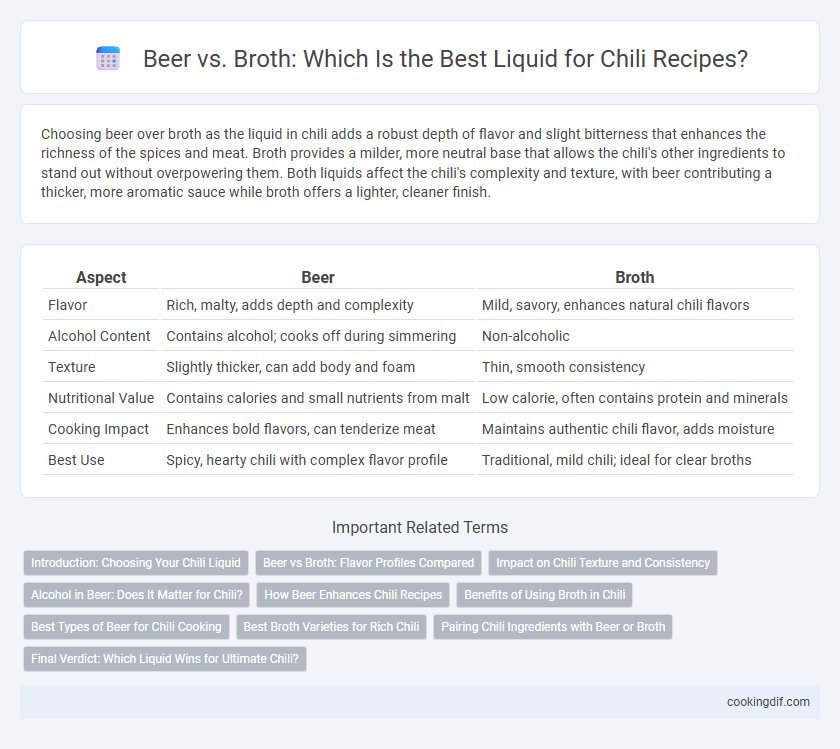Choosing beer over broth as the liquid in chili adds a robust depth of flavor and slight bitterness that enhances the richness of the spices and meat. Broth provides a milder, more neutral base that allows the chili's other ingredients to stand out without overpowering them. Both liquids affect the chili's complexity and texture, with beer contributing a thicker, more aromatic sauce while broth offers a lighter, cleaner finish.
Table of Comparison
| Aspect | Beer | Broth |
|---|---|---|
| Flavor | Rich, malty, adds depth and complexity | Mild, savory, enhances natural chili flavors |
| Alcohol Content | Contains alcohol; cooks off during simmering | Non-alcoholic |
| Texture | Slightly thicker, can add body and foam | Thin, smooth consistency |
| Nutritional Value | Contains calories and small nutrients from malt | Low calorie, often contains protein and minerals |
| Cooking Impact | Enhances bold flavors, can tenderize meat | Maintains authentic chili flavor, adds moisture |
| Best Use | Spicy, hearty chili with complex flavor profile | Traditional, mild chili; ideal for clear broths |
Introduction: Choosing Your Chili Liquid
Selecting the right liquid for chili significantly impacts flavor and texture, with beer and broth as popular options. Beer adds a rich, malty depth and subtle bitterness that enhances the chili's complexity, especially dark or amber varieties. Broth, typically beef or chicken, provides a savory, umami base that maintains the traditional, hearty character of the dish.
Beer vs Broth: Flavor Profiles Compared
Beer imparts a rich, malty depth to chili with subtle bitterness and caramel undertones, enhancing the dish's complexity. Broth offers a milder, savory base that allows spices and chili ingredients to stand out without overpowering the palate. Choosing beer versus broth for chili liquid depends on whether a more robust, layered flavor or a clearer, lighter foundation is desired.
Impact on Chili Texture and Consistency
Beer adds a rich, malty complexity to chili while contributing a slightly thicker consistency due to its carbonation and residual sugars, enhancing the overall texture. Broth, typically beef or chicken, offers a smoother and more neutral base that allows other spice flavors to shine without altering the chili's thickness significantly. Choosing beer intensifies both flavor depth and mouthfeel, whereas broth keeps the chili lighter and more balanced in texture.
Alcohol in Beer: Does It Matter for Chili?
The alcohol content in beer used for chili cooking typically evaporates during simmering, leaving behind rich flavors without affecting the dish's alcohol level. Beer adds depth and complexity to chili through its malt and hop flavors, enhancing the overall taste profile. For those concerned about alcohol, opting for broth ensures no residual alcohol while still providing a flavorful liquid base.
How Beer Enhances Chili Recipes
Beer enhances chili recipes by adding a rich depth of flavor and subtle bitterness that complements the spices and meat. The maltiness and carbonation in beer help tenderize the meat while creating a smooth, complex broth with roasted and caramel notes. Using beer as a cooking liquid boosts aroma and adds layers of savory complexity that plain broth alone cannot achieve.
Benefits of Using Broth in Chili
Using broth as the liquid base in chili enhances the depth of flavor with its savory, rich profile compared to water or beer. Broth contributes essential nutrients and moisture while maintaining a balanced taste that complements chili spices and ingredients. The natural umami from broth improves the overall texture and complexity, making the chili more satisfying and hearty.
Best Types of Beer for Chili Cooking
Using beer as the liquid base in chili adds rich malty flavors and complexity compared to broth, which offers a more neutral and subtle taste. The best types of beer for chili cooking include amber ales, stouts, and porters, as they impart deep, roasted notes and enhance the meatiness of the dish. Light lagers and pilsners are less suitable due to their delicate flavors, which can be overwhelmed by chili spices and ingredients.
Best Broth Varieties for Rich Chili
Choosing the right broth is essential for achieving rich, flavorful chili, with beef broth delivering deep, savory notes that enhance the meatiness of the dish. Chicken broth offers a lighter alternative that still provides a subtle depth without overpowering other ingredients. Vegetable broth suits vegetarian chili, infusing a complex, hearty base with layered flavors from diverse vegetables and herbs.
Pairing Chili Ingredients with Beer or Broth
Selecting the right liquid for chili significantly impacts flavor; beer adds a rich, malty depth that pairs well with bold spices, smoky meats, and robust chiles like ancho or chipotle. Broth, particularly beef or chicken, enhances the umami profile and balances heat, complementing ingredients such as beans, tomatoes, and sweet bell peppers. Combining beer and broth can create a complex base, marrying bitterness and savoriness to enrich chili's texture and taste.
Final Verdict: Which Liquid Wins for Ultimate Chili?
Beer adds depth and complexity with its rich malt and hop flavors, enhancing the chili's boldness and providing a subtle bitterness that balances the heat. Broth, typically beef or chicken, offers a more neutral, savory base that allows the chili spices and meat to shine without overpowering the dish. For the ultimate chili, beer often wins by elevating the overall flavor profile while maintaining the stew's hearty richness.
Beer vs Broth for chili liquid Infographic

 cookingdif.com
cookingdif.com